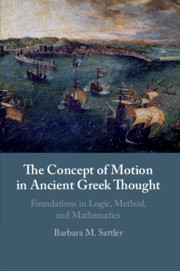Book contents
- The Concept of Motion in Ancient Greek Thought
- The Concept of Motion in Ancient Greek Thought
- Copyright page
- Contents
- Acknowledgements
- Introduction
- 1 Conceptual Foundations
- 2 Parmenides’ Account of the Object of Philosophy
- 3 Zeno’s Paradoxes of Motion and Plurality
- 4 The Atomistic Foundation for an Account of Motion
- 5 The Possibility of Natural Philosophy According to Plato I: The Logical Basis
- 6 The Possibility of Natural Philosophy According to Plato II: Mathematical Advances and Ultimate Problems
- 7 Aristotle’s Notion of Continuity: The Structure Underlying Motion
- 8 Time and Space: The Implicit Measure of Motion in Aristotle’s Physics
- 9 Time as the Simple Measure of Motion
- Bibliography
- Index Locorum
- General Index
4 - The Atomistic Foundation for an Account of Motion
Published online by Cambridge University Press: 28 September 2020
- The Concept of Motion in Ancient Greek Thought
- The Concept of Motion in Ancient Greek Thought
- Copyright page
- Contents
- Acknowledgements
- Introduction
- 1 Conceptual Foundations
- 2 Parmenides’ Account of the Object of Philosophy
- 3 Zeno’s Paradoxes of Motion and Plurality
- 4 The Atomistic Foundation for an Account of Motion
- 5 The Possibility of Natural Philosophy According to Plato I: The Logical Basis
- 6 The Possibility of Natural Philosophy According to Plato II: Mathematical Advances and Ultimate Problems
- 7 Aristotle’s Notion of Continuity: The Structure Underlying Motion
- 8 Time and Space: The Implicit Measure of Motion in Aristotle’s Physics
- 9 Time as the Simple Measure of Motion
- Bibliography
- Index Locorum
- General Index
Summary
This chapter discusses the atomistic account of motion, as an example of the first reactions to the Eleatic challenge by succeeding natural philosophers. The atomists are shown to change the logical basis by implicitly employing a different conception of negation that allows them to understand Being and non-Being as on a par. It also enables them to build a different ontological basis in which non-Being qua void plays a central role in natural philosophy. This new ontological basis allows the atomists to integrate the phenomenal world into their philosophy and to deal with the mereological problems bequeathed by Zeno’s paradoxes. The starting point for this development is the idea that what truly is must in some way also be responsible for the appearances of the phenomenal world. Generation on the phenomenal level is now understood as the combination and separation of aggregates of atoms, while change consists in the rearrangement of some parts of the aggregate. Although the atomists’ notion of the void can be seen as a predecessor to a notion of space, they do not in fact react to the spatio-temporal paradoxes of Zeno.
- Type
- Chapter
- Information
- The Concept of Motion in Ancient Greek ThoughtFoundations in Logic, Method, and Mathematics, pp. 176 - 201Publisher: Cambridge University PressPrint publication year: 2020



